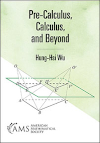- About MAA
- Membership
- MAA Publications
- Periodicals
- Blogs
- MAA Book Series
- MAA Press (an imprint of the AMS)
- MAA Notes
- MAA Reviews
- Mathematical Communication
- Information for Libraries
- Author Resources
- Advertise with MAA
- Meetings
- Competitions
- Programs
- Communities
- MAA Sections
- SIGMAA
- MAA Connect
- Students
- MAA Awards
- Awards Booklets
- Writing Awards
- Teaching Awards
- Service Awards
- Research Awards
- Lecture Awards
- Putnam Competition Individual and Team Winners
- D. E. Shaw Group AMC 8 Awards & Certificates
- Maryam Mirzakhani AMC 10 A Awards & Certificates
- Two Sigma AMC 10 B Awards & Certificates
- Jane Street AMC 12 A Awards & Certificates
- Akamai AMC 12 B Awards & Certificates
- High School Teachers
- News
You are here
Pre-Calculus, Calculus, and Beyond

Buy Now:
Publisher:
AMS
Publication Date:
2020
Number of Pages:
417
Format:
Paperback
Price:
50.00
ISBN:
978-1-4704-5677-1
[Reviewed by , on ]
Peter Olszewski
11/28/2021
Pre-Calculus, Calculus, and Beyond is the final volume of the three-part series. The first two volumes are Rational Numbers to Linear Equations and Algebra and Geometry. This final volume gives the reader a detailed overview of topics meant for grades 9 – 12 in line with Common Core State Standards for Mathematics (CCSSM). This text is geared for high school mathematics teachers and mathematics teacher educators. The topics presented are to help teachers and faculty recall the mathematics needed to teach and serve as a basis for research topics. Wu argues that Textbook School Mathematics (TSM) texts remain unchanged and presents findings to help correct the decades-old misunderstandings.
Wu believes that the concepts of exponential functions, logarithmic functions, and radian measures are sufficiently discussed at the middle and high school levels but that teachers can’t get to a deep understanding and discussion of limits, which are embedded in each of the aforementioned topics. Wu uses four categories - Definitions, Reasoning, Precision, and Coherence – to further explain why this deep understanding is necessary. The author includes a discussion on the domain of log x and the middle and high school concepts needed for Calculus, including the relationship of graphs of sine and cosine to the unit circle. Wu goes on to prove the theorem: Every repeating decimal is equal to a fraction, using two special cases, \( 0.\overline{345} \) and \( 0.82\overline{345} \), which adds further emphasis on limits and repeating decimals. Finally, the author covers the Mean Value Theorem in an especially well-written section, weaving Fermat’s Theorem into the proof of the Mean Value Theorem with the corollary, Rolle’s Theorem.
This final volume puts in perspective how we as educators need to re-think how we present solutions and main concepts in our lectures. Middle, high school, and college-level instructors could benefit from this text. My one concern is how well it may be received by the students, especially with two-plus years of COVID-19 and remote learning. Let’s face it, many are burned out from this pandemic and it may be difficult to re-think decisions in lectures. Of course, that is not an excuse to ignore the topics presented in Wu’s text. From personal experience, engineering students may not take well to these ideas, but a mathematics major may be intrigued.
Peter Olszewski, M.S., is a Mathematics Lecturer at The Pennsylvania State University, The Behrend College, an editor for Larson Texts, Inc. in Erie, PA, and is the 362nd Chapter Advisor of the Pennsylvania Alpha Beta Chapter of Pi Mu Epsilon. His Research fields are in mathematics education, Cayley Color Graphs, Markov Chains, and mathematical textbooks. He can be reached at pto2@psu.edu or www.personal.psu.edu/pto2. Outside of teaching and textbook editing, he enjoys playing golf, playing guitar and bass, reading, gardening, traveling, and painting landscapes.
See the publisher's website.
- Log in to post comments




